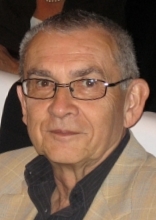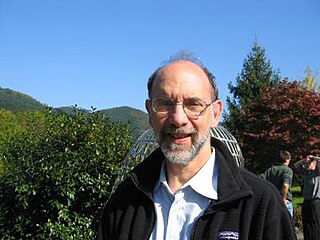
Vladimir Alexandrovich Voevodsky was a Russian-American mathematician. His work in developing a homotopy theory for algebraic varieties and formulating motivic cohomology led to the award of a Fields Medal in 2002. He is also known for the proof of the Milnor conjecture and motivic Bloch–Kato conjectures and for the univalent foundations of mathematics and homotopy type theory.
In algebraic geometry, motives is a theory proposed by Alexander Grothendieck in the 1960s to unify the vast array of similarly behaved cohomology theories such as singular cohomology, de Rham cohomology, etale cohomology, and crystalline cohomology. Philosophically, a "motif" is the "cohomology essence" of a variety.
Algebraic K-theory is a subject area in mathematics with connections to geometry, topology, ring theory, and number theory. Geometric, algebraic, and arithmetic objects are assigned objects called K-groups. These are groups in the sense of abstract algebra. They contain detailed information about the original object but are notoriously difficult to compute; for example, an important outstanding problem is to compute the K-groups of the integers.
Motivic cohomology is an invariant of algebraic varieties and of more general schemes. It is a type of cohomology related to motives and includes the Chow ring of algebraic cycles as a special case. Some of the deepest problems in algebraic geometry and number theory are attempts to understand motivic cohomology.
In mathematics, homotopical algebra is a collection of concepts comprising the nonabelian aspects of homological algebra, and possibly the abelian aspects as special cases. The homotopical nomenclature stems from the fact that a common approach to such generalizations is via abstract homotopy theory, as in nonabelian algebraic topology, and in particular the theory of closed model categories.

Yuri Ivanovich Manin was a Russian mathematician, known for work in algebraic geometry and diophantine geometry, and many expository works ranging from mathematical logic to theoretical physics.
In mathematics, the Milnor conjecture was a proposal by John Milnor of a description of the Milnor K-theory (mod 2) of a general field F with characteristic different from 2, by means of the Galois cohomology of F with coefficients in Z/2Z. It was proved by Vladimir Voevodsky.
In mathematics, Milnor K-theory is an algebraic invariant defined by John Milnor as an attempt to study higher algebraic K-theory in the special case of fields. It was hoped this would help illuminate the structure for algebraic K-theory and give some insight about its relationships with other parts of mathematics, such as Galois cohomology and the Grothendieck–Witt ring of quadratic forms. Before Milnor K-theory was defined, there existed ad-hoc definitions for and . Fortunately, it can be shown Milnor K-theory is a part of algebraic K-theory, which in general is the easiest part to compute.

Alexander A. Beilinson is the David and Mary Winton Green University professor at the University of Chicago and works on mathematics. His research has spanned representation theory, algebraic geometry and mathematical physics. In 1999, Beilinson was awarded the Ostrowski Prize with Helmut Hofer. In 2017, he was elected to the National Academy of Sciences. In 2018, he received the Wolf Prize in Mathematics and in 2020 the Shaw Prize in Mathematics.

Spencer Janney Bloch is an American mathematician known for his contributions to algebraic geometry and algebraic K-theory. Bloch is a R. M. Hutchins Distinguished Service Professor Emeritus in the Department of Mathematics of the University of Chicago. He is a member of the U.S. National Academy of Sciences and a Fellow of the American Academy of Arts and Sciences and of the American Mathematical Society. At the International Congress of Mathematicians, he gave an invited lecture in 1978 and a plenary lecture in 1990. He was a visiting scholar at the Institute for Advanced Study in 1981–82. He received a Humboldt Prize in 1996. He also received a 2021 Leroy P. Steele Prize for Lifetime Achievement.
In mathematics, the norm residue isomorphism theorem is a long-sought result relating Milnor K-theory and Galois cohomology. The result has a relatively elementary formulation and at the same time represents the key juncture in the proofs of many seemingly unrelated theorems from abstract algebra, theory of quadratic forms, algebraic K-theory and the theory of motives. The theorem asserts that a certain statement holds true for any prime and any natural number . John Milnor speculated that this theorem might be true for and all , and this question became known as Milnor's conjecture. The general case was conjectured by Spencer Bloch and Kazuya Kato and became known as the Bloch–Kato conjecture or the motivic Bloch–Kato conjecture to distinguish it from the Bloch–Kato conjecture on values of L-functions. The norm residue isomorphism theorem was proved by Vladimir Voevodsky using a number of highly innovative results of Markus Rost.
In mathematics, the Quillen–Lichtenbaum conjecture is a conjecture relating étale cohomology to algebraic K-theory introduced by Quillen, who was inspired by earlier conjectures of Lichtenbaum (1973). Kahn (1997) and Rognes & Weibel (2000) proved the Quillen–Lichtenbaum conjecture at the prime 2 for some number fields. Voevodsky, using some important results of Markus Rost, has proved the Bloch–Kato conjecture, which implies the Quillen–Lichtenbaum conjecture for all primes.

Aleksandr Sergeyevich Merkurjev is a Russian-American mathematician, who has made major contributions to the field of algebra. Currently Merkurjev is a professor at the University of California, Los Angeles.
Robert Wayne Thomason was an American mathematician who worked on algebraic K-theory. His results include a proof that all infinite loop space machines are in some sense equivalent, and progress on the Quillen–Lichtenbaum conjecture.

Eric Mark Friedlander is an American mathematician who is working in algebraic topology, algebraic geometry, algebraic K-theory and representation theory.
Amalendu Krishna is an Indian mathematician in the Department of Mathematics, Indian Institute of Science (IISc), Bangalore, specializing in algebraic cycles and K-theory. He was awarded the Shanti Swarup Bhatnagar Prize for Science and Technology, India's highest prize for excellence in science, mathematics and technology, in the mathematical sciences category in the year 2016.
In algebraic geometry, a relative cycle is a type of algebraic cycle on a scheme. In particular, let be a scheme of finite type over a Noetherian scheme , so that . Then a relative cycle is a cycle on which lies over the generic points of , such that the cycle has a well-defined specialization to any fiber of the projection .(Voevodsky & Suslin 2000)

Uwe Jannsen is a German mathematician, specializing in algebra, algebraic number theory, and algebraic geometry.
In algebraic geometry, a correspondence between algebraic varieties V and W is a subset R of V×W, that is closed in the Zariski topology. In set theory, a subset of a Cartesian product of two sets is called a binary relation or correspondence; thus, a correspondence here is a relation that is defined by algebraic equations. There are some important examples, even when V and W are algebraic curves: for example the Hecke operators of modular form theory may be considered as correspondences of modular curves.
Mikhail Kapranov, is a Russian mathematician, specializing in algebraic geometry, representation theory, mathematical physics, and category theory. He is currently a professor of the Kavli Institute for the Physics and Mathematics of the Universe at the University of Tokyo.







